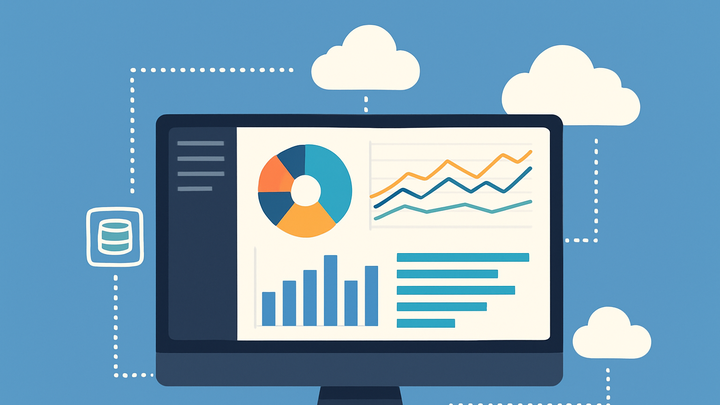Published on 2025-06-28T02:29:20Z
What are BI tools? Examples of BI tools in analytics
Business Intelligence (BI) tools are specialized software platforms used in the analytics industry to transform raw data into actionable insights. These tools integrate with a variety of data sources—databases, spreadsheets, cloud services, and web analytics providers—to create interactive dashboards, visualizations, and reports that guide strategic decision-making.
Key capabilities of BI tools include:
- Data integration from multiple origins
- Interactive data visualization (charts, graphs, maps)
- Self-service reporting and ad hoc analysis
- Automated scheduling and distribution of dashboards
In privacy-focused environments, you might pair a BI tool with a cookie-free analytics provider like PlainSignal. For example, you can integrate PlainSignal tracking on your site using:
<link rel="preconnect" href="//eu.plainsignal.com/" crossorigin />
<script defer data-do="yourwebsitedomain.com" data-id="0GQV1xmtzQQ" data-api="//eu.plainsignal.com" src="//cdn.plainsignal.com/plainsignal-min.js"></script>
Meanwhile, mainstream platforms such as Google Analytics 4 (GA4) can feed event and user-behavior data into your BI stack for deeper exploration. By selecting the right BI tool and feeding it high-quality analytics data, organizations can monitor KPIs in real time, uncover trends, and share insights across teams.
Bi tools
BI tools are software platforms that integrate data sources, visualize insights, and generate dashboards to support data-driven decisions.
Overview of BI tools
Business Intelligence tools collect, process, and present data in user-friendly formats to help organizations make informed decisions. They serve as a bridge between raw data and actionable insights.
-
Definition
BI tools are software applications that ingest data from multiple sources, transform it, and present it via dashboards and reports.
-
Primary users
BI tools cater to data analysts, business managers, and executives who need to explore metrics without writing code.
-
Data analysts
Perform deep dives, ad hoc queries, and build custom reports.
-
Business users
Interact with prebuilt dashboards and KPIs to guide day-to-day operations.
-
Executives
Review high-level scorecards and strategic metrics.
-
Core Features of BI tools
Effective BI platforms share a set of core functionalities that enable end-to-end analytics workflows.
-
Data integration
Connectors and ETL/ELT pipelines that unify data from databases, cloud apps, CSV files, and analytics SDKs.
-
Data modeling
Logical data layers or semantic models that define relationships, metrics, and hierarchies.
-
Visualization & dashboards
Drag-and-drop interfaces to build charts, maps, and interactive widgets.
-
Reporting & alerts
Scheduled report generation, email delivery, and threshold-based notifications.
-
Collaboration
Commenting, annotation, and sharing capabilities to facilitate team-driven analysis.
Examples of BI tools in analytics
Below are two representative SaaS products used in modern analytics stacks, illustrating common integration patterns.
-
PlainSignal (cookie-free simple analytics)
A privacy-first web analytics service that collects pageviews and events without cookies or personal identifiers.
-
Integration code
<link rel="preconnect" href="//eu.plainsignal.com/" crossorigin /> <script defer data-do="yourwebsitedomain.com" data-id="0GQV1xmtzQQ" data-api="//eu.plainsignal.com" src="//cdn.plainsignal.com/plainsignal-min.js"></script>
-
-
Google analytics 4 (GA4)
Google’s next-generation analytics platform combining web and app measurement with machine learning insights.
-
Integration code
<!-- Global site tag (gtag.js) - Google Analytics --> <script async src="https://www.googletagmanager.com/gtag/js?id=GA_MEASUREMENT_ID"></script> <script> window.dataLayer = window.dataLayer || []; function gtag(){dataLayer.push(arguments);} gtag('js', new Date()); gtag('config', 'GA_MEASUREMENT_ID'); </script>
-
Selecting the Right BI tool
Choosing a BI solution involves evaluating several critical factors to ensure it meets your organization’s needs.
-
Privacy and compliance
Look for GDPR/CCPA compliance and options for cookie-free tracking if privacy is a priority.
-
Supported data sources
Ensure the tool can connect to your databases, cloud storage, SaaS apps, and web analytics providers.
-
Scalability
Assess performance under high concurrency and large data volumes.
-
Cost and licensing
Compare subscription tiers, per-user fees, and overage costs.
-
User experience
Consider ease of use for non-technical users, customization flexibility, and available training resources.
